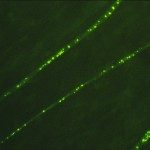Link to Pubmed [PMID] – 19247444
PLoS Pathog. 2009 Feb;5(2):e1000315
Human neurons express the innate immune response receptor, Toll-like receptor 3 (TLR3). TLR3 levels are increased in pathological conditions such as brain virus infection. Here, we further investigated the production, cellular localisation, and function of neuronal TLR3 during neuronotropic rabies virus (RABV) infection in human neuronal cells. Following RABV infection, TLR3 is not only present in endosomes, as observed in the absence of infection, but also in detergent-resistant perinuclear inclusion bodies. As well as TLR3, these inclusion bodies contain the viral genome and viral proteins (N and P, but not G). The size and composition of inclusion bodies and the absence of a surrounding membrane, as shown by electron microscopy, suggest they correspond to the previously described Negri Bodies (NBs). NBs are not formed in the absence of TLR3, and TLR3(-/-) mice — in which brain tissue was less severely infected — had a better survival rate than WT mice. These observations demonstrate that TLR3 is a major molecule involved in the spatial arrangement of RABV-induced NBs and viral replication. This study shows how viruses can exploit cellular proteins and compartmentalisation for their own benefit.

